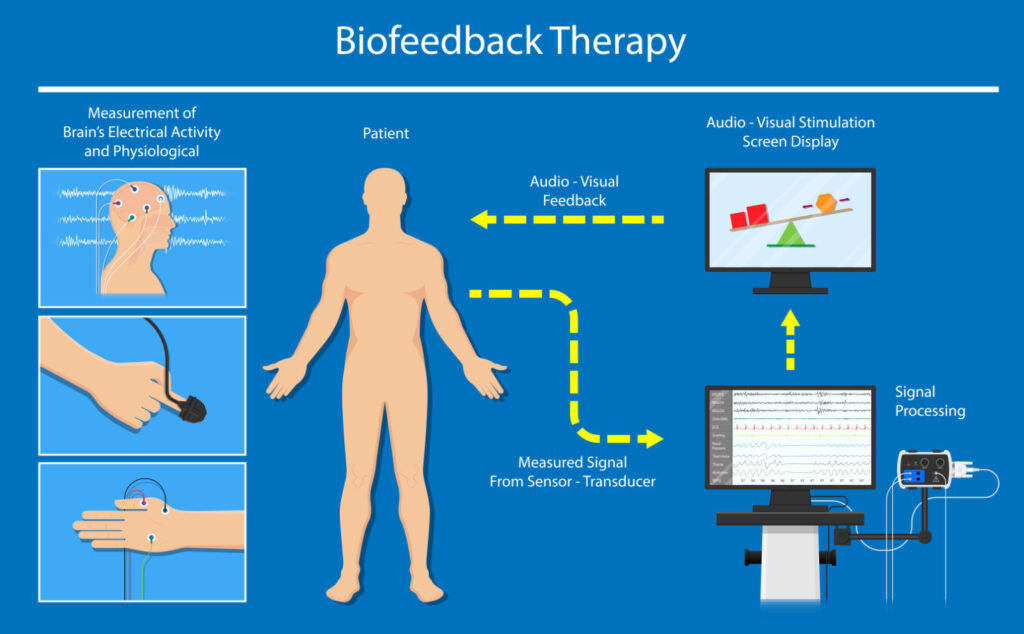IM&BW specializes in providing biofeedback treatments that include Heart-Rate Variability (HRV), SEMG (muscle biofeedback) in the Castle Rock & Colorado Springs region in addition to other mental health treatment options.
Biofeedback is a treatment technique supporting increased voluntary control over various body functions. Consequently, increased awareness and control supports improving and maintaining autonomic nervous system balance between one's sympathetic nervous system (fight/flight response) and parasympathetic nervous system (rest & digest or freeze). In other words, keeping one's cognitive, emotional & physical states within a "window of tolerance". As an individual's autonomic nervous system may become imbalanced due to a specific disorder or to daily environmental stressors or past physical and/or emotional trauma, one may easily find oneself outside of this window of tolerance. For example, during states of hyper-arousal (sympathetic dominance) and hypo-arousal (parasympathetic dominance). Biofeedback is proven to assist in achieving states of autonomic balance allowing us day-to-day to remain within our optimal window of tolerance. Optimal neurological function maintains homeostasis across life's ever-changing situations to achieve balance.

The result of biofeedback assists in becoming more aware and detect internal sensations within the body (increased interoception) and subsequently, make subtle changes in your body. Examples are improving heart-rate variability (HRV) to achieve better adaptability and resilience or to decrease muscle tension caused by dysponesis (misplaced effort). Utilizing increased control to elevate skin temperature while reducing skin conductance (sweating) when stress sets in serves as an additional example. Biofeedback allows an individual to take charge of their physiological responses often for improving a specific health condition, reducing stress/anxiety or, simply for improving day-to-day functioning with greater physical/emotional performance (optimal performance).
Types of biofeedback:
Your therapist might use a variety of biofeedback methods depending on your goals in addition to assessment results. Biofeedback types include:
- Heart rate Variability (HRV). This type of feedback uses finger or earlobe sensors with a device used to detect blood volume changes (photoplethysmograph). Additionally, sensors may be placed on the chest, lower torso or wrists using electrocardiograph (ECG) to measure heart rate and how heart rate varies.
- Respiration/Breathing. Bands are placed around the abdomen and/or chest to monitor breathing patterns and respiration rate.
- Muscle contraction (SEMG). This type involves placing sensors over your skeletal muscles with an electromyograph (EMG) to monitor the electrical activity that causes muscle contraction.
- Sweat gland activity. In order to measure activity of sweat glands, sensors are attached around the fingers or on the palm or wrist with an electrodermograph (EDG). The amount of perspiration on the skin correlates with levels of arousal.
- Temperature. Sensors attached to your fingers or feet measure blood flow to your skin. Since body temperature drops correspond to stress a low reading may prompt you to begin relaxation techniques.
- Neurofeedback/Brain waves. This type uses scalp sensors to monitor your brain waves using an electroencephalograph (EEG).
Watch this Ted Talk on HRVB by Dr. Inna Khazan (Harvard Medical School)
Conditions treated with Biofeedback:
Physical and mental health issues, including:
- Anxiety and/or stress
- ADHD (child & adult)
- Depression
- Chronic pain
- Headache
- High blood pressure/hypertension
- Autism
- Preeclampsia
- Sleep Issues/Insomnia
- PTSD
- Temporomandibular joint disorder (TMJ)
Biofeedback appeals to people for a variety of reasons:
- It's noninvasive.
- Potential for reducing or eliminating the need for medications.
- Potential to enhance the benefits of medications.
- It might help women who can't take medication during pregnancy.
- It helps people feel more in control of their health.
Biofeedback Session structure:
During a biofeedback session, a therapist attaches electrical sensors to different parts of the body. Subsequently , sensors monitor and provide visual feedback on activity such as skin temperature, muscle tension, heart rate and breathing. This information is then fed back to you via audio cues or visually through changes on a monitor.
Ongoing feedback is continuously paired with our clinical knowledge for both physiological and covert cognitive/emotional processes. Clients are taught to change or control their body's reactions by changing thoughts, emotions or behavioral patterns (ie. response patterns). In turn, conditions for which treatment is sought align with proactive and reactive strategies for improving overall functioning.
The ultimate goal with biofeedback is to learn to use these techniques at home on your own.
A typical biofeedback session lasts 30 to 60 minutes that depends on response to treatment and engagement in home practice.